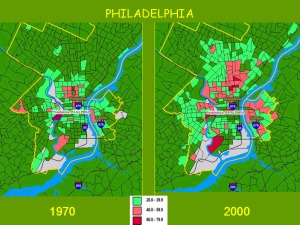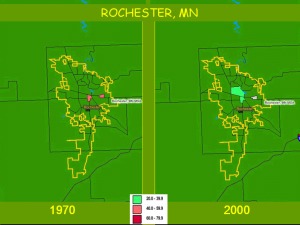Geography, Poverty and Health Care
Is poverty the major factor underlying geographic variation in health care? It assuredly is. There is abundant evidence that poverty is strongly associated with poor health status, greater per capita health care spending, more hospital readmissions and poorer outcomes.  It is the single strongest factor in variation in health care and the single greatest contributor to “excess” health care spending. It should be the focus of health care reform but, sadly, many provisions in the current bills will worsen the problem.
It is the single strongest factor in variation in health care and the single greatest contributor to “excess” health care spending. It should be the focus of health care reform but, sadly, many provisions in the current bills will worsen the problem.
Much of this is discussed elsewhere on this blog and in our recent “Report to The President and The Congress.” In this posting, I would simply like to tap into your common sense. We all know that poverty is geographic. There are wealthy neighborhoods and impoverished ones, rich states and poor ones, developed countries and developing ones. Sometimes poverty is regional, as in Mississippi, but sometimes it’s confined to “poverty ghettos,” as in the South Bronx. These differences confound most of the statistical analyses that you’ve heard about.  I’d like to show you poverty, how and where it exists and how it has changed over the past several decades. I will call your attention to areas that have low or high health care spending, including those that the President and his advisors hold out as models for the future. The maps are all from the Bruton Center at the University of Texas in Dallas.
I’d like to show you poverty, how and where it exists and how it has changed over the past several decades. I will call your attention to areas that have low or high health care spending, including those that the President and his advisors hold out as models for the future. The maps are all from the Bruton Center at the University of Texas in Dallas.
Poverty exists most dramatically in the  “poverty ghettos” of major cities, such as New York, Newark, Philadelphia, Chicago, Los Angeles, Houston, Miami and Milwaukee, and in each, these ghettos have progressively grown over the period from 1970 to 2000. Each of these cities has been cited for its high health care spending, and most are home to academic medical centers with high costs. In each, poverty is surrounded by wealth – the “Affluence-Poverty Nexus.” As a result, averaging, as occurs in most studies, obfuscates poverty’s pervasive effects. Indeed, by disaggregating, we have shown that Milwaukee’s poverty ghetto explains its higher costs, and Dr. Tom Rosenthal at UCLA has shown the same in Los Angeles.
“poverty ghettos” of major cities, such as New York, Newark, Philadelphia, Chicago, Los Angeles, Houston, Miami and Milwaukee, and in each, these ghettos have progressively grown over the period from 1970 to 2000. Each of these cities has been cited for its high health care spending, and most are home to academic medical centers with high costs. In each, poverty is surrounded by wealth – the “Affluence-Poverty Nexus.” As a result, averaging, as occurs in most studies, obfuscates poverty’s pervasive effects. Indeed, by disaggregating, we have shown that Milwaukee’s poverty ghetto explains its higher costs, and Dr. Tom Rosenthal at UCLA has shown the same in Los Angeles.
 The second way that poverty exists is regionally, for example in broad expanses of Appalachia and the south, where total health care spending is low because regional resources are meager. This is reflected in poor outcomes. Indeed, if the south had become a separate nation, its outcomes would be the worst of any developed nation in the world.
The second way that poverty exists is regionally, for example in broad expanses of Appalachia and the south, where total health care spending is low because regional resources are meager. This is reflected in poor outcomes. Indeed, if the south had become a separate nation, its outcomes would be the worst of any developed nation in the world.  Similar regions of poverty exist in Texas and the southwest but not in the northeast or Midwest, where poverty is concentrated in urban ghettos. Curiously, broad regional expanses of poverty, like in the south, have lessened as poverty has become more concentrated in urban centers.
Similar regions of poverty exist in Texas and the southwest but not in the northeast or Midwest, where poverty is concentrated in urban ghettos. Curiously, broad regional expanses of poverty, like in the south, have lessened as poverty has become more concentrated in urban centers.
 The third image of poverty is as it appears in the communities that have been held out as models for health care: Rochester MN (Mayo), Danville PA (Geisinger), Seattle (Group Health), Hanover (Dartmouth) and both Grand Junction and Green Bay, which the President visited. Each is distinguished by an absence of poverty ghettos, even as ghettos enlarge in major urban centers.
The third image of poverty is as it appears in the communities that have been held out as models for health care: Rochester MN (Mayo), Danville PA (Geisinger), Seattle (Group Health), Hanover (Dartmouth) and both Grand Junction and Green Bay, which the President visited. Each is distinguished by an absence of poverty ghettos, even as ghettos enlarge in major urban centers. Communities such as these are models for an ideal that some may feel is possible, but not for the bulk of Americans, who live in markedly different urban environments, with their complex populations, admixtures of wealth and poverty and enormous health care needs.
Communities such as these are models for an ideal that some may feel is possible, but not for the bulk of Americans, who live in markedly different urban environments, with their complex populations, admixtures of wealth and poverty and enormous health care needs.
These images are important to retain as you sift through statistical analyses that are difficult to judge but that have led to counterintuitive conclusions about the basis for regional variation in health care. Stick with your instincts. Hold on to common sense. P-o-v-e-r-t-y matters. There’s still a chance to reform health care right.

Womans clinics and birth control is very important to control poverty. I can not understand why abortion and clinics are not the prority to help poor people.
Medical care jobs are the hottest occupation planning today. There is actually an incredibly wide range involving job options for individuals who wish to take up medical with out …student health plan